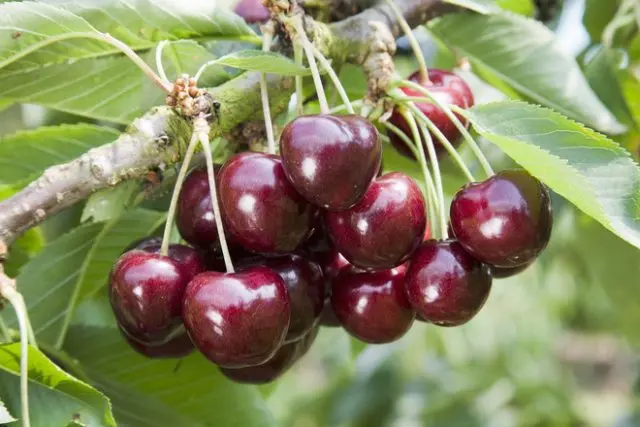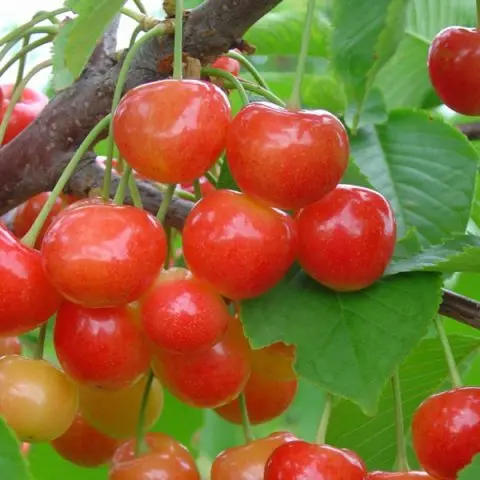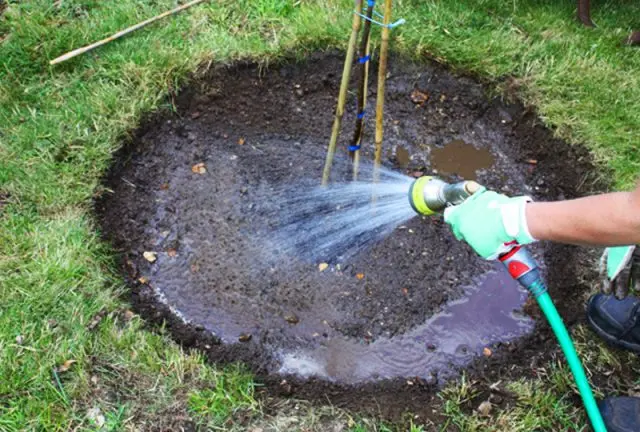Contents
- Does cherry grow in the Leningrad region
- Cherry varieties for the Leningrad region
- Planting cherries in the Leningrad region
- Cherry cultivation in the Leningrad region
- The best varieties of sweet cherries for the North-West
- Cherry planting in the North-West of Our Country
- Cherry cultivation in the Northwest
- Conclusion
- Reviews
Sweet cherry for the Leningrad region is a unique fruit and berry crop. Its varieties have numerous advantages: frost resistance, self-fertility, unpretentiousness. This made it a popular planting in summer cottages, on farms.
Does cherry grow in the Leningrad region
The Leningrad region belongs to the North-West region. The climate here is continental: winter is mild, summer is warm. The peculiarity of the region is unstable weather conditions during the warm period. The changeable climate creates specific conditions for growing fruit and berry crops.
Cherry is a thermophilic tree. For a long time, only the southern regions served as the territory for its landing. In the course of a series of selective experiments, scientists were able to create and grow varieties for the Northwest region. For many years they have experimentally proven the possibility of planting, growing, and developing sweet cherries in a changeable climate. Thanks to their work, the fruit and berry crop has firmly taken root in the farming of the Leningrad Region. Modern summer residents plant a variety of species on their plots. They enthusiastically cultivate early, late varieties.

Cherry varieties for the Leningrad region
Sweet cherry in the Leningrad region is a common planting. Specially bred varieties respond well to the rather harsh weather conditions of the region. Main types:
- Oryol amber.
- Ovstuzhenka.
- Victory.
- Pink Bryansk.
- Leningrad black.
- Tyutchevka.
Winter-hardy varieties of sweet cherries for the Leningrad region
A high winter hardiness is an important feature of the variety planted in the Leningrad region. Winters here are quite severe. The tree must withstand significant changes in low temperatures. Several varieties show an excellent reaction to the cold:
- Iput. Withstands up to -32 degrees.
- Revna. Frost resistance is above average. The tree is able to endure harsh winters without much damage to the trunk, branches.
- Drogana is yellow. It has a high level of resistance to northwestern frosts. Tree buds tolerate temperatures as low as -20 degrees.
- Fatej. The buds of the plant have an average resistance to cold. Trunks, branches cope well with low temperatures.
- Bryansk pink. The trunk and branches are characterized by a high threshold of frost resistance. Tree buds should be protected from sudden changes in temperature.
- Leningrad black. The variety is the leader in terms of winter hardiness. Due to this, it is considered the most popular in the North-West region.
Low-growing varieties of sweet cherries for the Leningrad region
Due to the peculiarities of the climate, strong winds often blow in the Leningrad Region during the cold season. Low-growing trees will be less susceptible to destructive influence from drafts, gusts of wind:
- Raditsa. The average height of the trunk with a compact crown is 2-3 m.
- Ovstuzhenka. Low variety. The maximum height is 3 m.
- Regina. Small tree – 2-3 m.
- Revna. A small variety with a pyramidal crown. The average height is 2 m.
Self-fertile varieties of sweet cherry for the Leningrad region
The self-fertility of a tree is the ability to bear fruit without the presence of additional pollinators. Among the varieties of the Leningrad region, there are practically no trees with such a possibility. Thanks to selective experiments, the following self-fertile varieties were bred:
- Ovstuzhenka. Possesses conditional self-fertility. Its pollination is carried out within a single tree.
- Revna. The species does not need additional pollinators to form fruits.
- Homestead yellow. The variety is self-fertile, brings abundant harvests.
- Large cherry. A partially self-fertile variety will require pollinators – Valery Chkalov, Francis, Bigarro Oratovsky.
Which cherry is better for the Leningrad region
The Leningrad region is a specific environment for the cultivation of fruit plants. The area is known for frosty winters, wet cool summers, changeable weather. Gardeners in this region consider several varieties to be the most suitable:
- Leningrad black. It has a number of undeniable advantages. Due to this, it is widely distributed in the areas of gardeners, amateur summer residents. The tree is resistant to severe frosts. The variety is characterized by rapid growth, fruiting 3 years after planting. One of the features is that ripe fruits do not crumble for a long time. The variety needs additional pollinators (Iput, Tyutchevka, Fatezh, Ovstuzhenka).Cherry ordinary Leningrad black 🌿 overview: how to plant, seedlings of sweet cherries Leningrad black
- Ovstuzhenka. Early variety. Its fruits ripen in June 5 years after planting. A low tree has a particularly high level of frost resistance.
- Revna. It is characterized by rapid growth, medium late fruit ripening. A distinctive feature is high resistance to plant diseases.
Planting cherries in the Leningrad region
The main problem of planting sweet cherries in the Leningrad region is the death of seedlings due to frost. You should follow simple recommendations:
- Planting cuttings is carried out at the end of April. They will have time to adapt to the climate, get stronger before the onset of winter.
- For planting, choose the sunniest place on the site.
- The seedling must be protected from wind, drafts.
- The best option is a hill, a hill. In the lowland there is a high level of groundwater occurrence. This will ruin the roots of the tree.

Cherry cultivation in the Leningrad region
Growing sweet cherries in the Leningrad region will not cause much trouble if you take careful measures to care for the plant:
- Regular watering with warm water. Before moistening, the soil is loosened.
- Mandatory fertilizer with organic matter.
- Weed weeding.
- Pruning branches annually.
- Mandatory measures to protect against diseases and pests. The net will save the tree from birds. From diseases – treatment with appropriate solutions of insecticides.
The best varieties of sweet cherries for the North-West
The Northwest region covers several areas with a changeable cold climate. The cultivation of fruit and berry crops here is associated with a strict selection of varieties in accordance with frost resistance, self-fertility of trees.
Winter hardy
Frost resistance is the main criterion by which a plant is chosen for planting in their areas. Have high winter hardiness:
- Oryol amber. An early variety with high frost resistance. It tolerates up to -20 degrees without damage.
- Bryansk Pink. The tree responds well to temperature changes in winter.
- Cheremashnaya. An early variety tolerates frost well. Branches, buds are not damaged at temperatures up to -20 degrees.
- Homestead yellow. It can grow in the mode up to -30 degrees.

Low-growing
Low-growing varieties in the North-West region are valued as highly as frost-resistant ones:
- Radica – a low tree with a very compact crown.
- Knowledge. Low variety with spreading crown.
self fertile
Self-fertility is a significant advantage of varieties in the North-West region. Few species can do without a pollinator:
- Cherry Folk Syubarova. The tree reaches a height of 6 m. For the formation of fruits, it does not need additional pollinating varieties.
- Homestead yellow. Produces a crop of sweet yellow fruits without the help of pollinators.
Cherry planting in the North-West of Our Country
Planting seedlings in the North-West region is a standard procedure. There is a simple algorithm:
- The period is early spring.
- The place is sunny, windless, protected from drafts.
- The pit under the cutting is filled with a mixture of soil and organic fertilizers.
- The root neck of the seedling must be open (no more than 5 cm).
- Planting is tamped, watered, mulched.
Cherry cultivation in the Northwest
There are a number of features of growing fruit and berry crops in the frosty climate of the North-West region:
- Creation of artificial protection against drafts, winds.
- Careful selection of landing sites. It is necessary to monitor the level of groundwater.
- Optimal watering.
- Top dressing. Tree fertilization is carried out in accordance with the season. It is important to support the plant during flowering, fruit set, before the onset of cold weather.
- Despite the high frost resistance, cherries should be additionally insulated. The roots are covered with coniferous sawdust, the trunk is treated with a solution of lime.

Conclusion
Cherry for the Leningrad region is a popular horticultural crop with many advantages. Summer residents of this region plant winter-hardy, self-fertile varieties on their plots. Trees do not require careful care, and their berries are distinguished by a special sweetness of taste.









